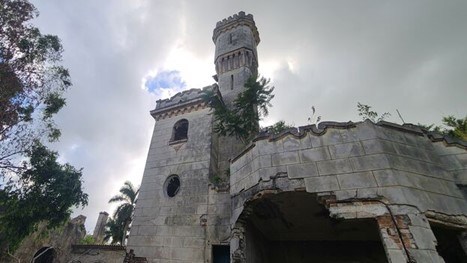converted into a Military Zone and a beggars’ refuge

The La Luisa farm belonged to one of Cuba’s most important politicians before being expropriated, and then abandoned, by the Government of Fidel Castro.
By Nelson García & Juan Izquierdo (14ymedio)
HAVANA TIMES – No one enters the ruins of the La Luisa farm, in the Havana municipality of Arroyo Naranjo, with good intentions. Where one of the most powerful families in Cuba once lived, now only beggars dare to sleep, surrounded by walls full of graffiti and vines. The sporadic visitors to the “castle” – the building retains its towers and walkways – are now criminals seeking temporary shelter to escape from the Police and young people who, according to the neighbors, come to “do evil things.”
La Luisa was one of the first properties confiscated by Fidel Castro after 1959. Its owner, the lawyer and politician José Manuel Cortina – who served as chancellor of the Republic on two occasions – was accused of being a “landowner” and died in exile in 1970.
The officials who occupied the “castle” after the triumph of the Revolution then received an order from Che Guevara: to install a metallurgy laboratory that ended up becoming the Research Center for the Mining and Metallurgical Industry (Cipimm). “That didn’t last long,” Jorge tells 14ymedio; he now works in the new offices of that institution, not far from La Luisa.
Without maintenance and after numerous instances of neglect, the old Cortina house ended up collapsing. “One day, all the pipes were clogged, the drainage system failed and the bathrooms were unusable,” says Jorge. Shortly after, the “castle” was abandoned.
Over time, the Cortina lands – which bordered those of the family of former president Carlos Prío Socarrás – became a military zone. Now, the Army officers’ houses, as well as the new Cipimm – dedicated to studying the possibilities of gold and nickel exploitation in Cuba – are located where Republican politicians once built their summer estates.
“Many efforts were made, when the Historian of Havana Eusebio Leal was alive, for that Office to restore the ’castle’, but to no avail,” Jorge alleges. According to Leal’s architects, it was useless to repair La Luisa: no tourist was going to go to Arroyo Naranjo to see the building, no matter how interesting the construction.
No one else was interested in the farm, where several scenes from the Cuban-Spanish co-production The Nights of Constantinople were filmed, directed in 2001 by Orlando Rojas and featuring actors of the caliber of Francisco Rabal, Verónica Lynn, Rosita Fornés and María Isabel Díaz. However, the film failed to attract the authorities attention to the building.
A concrete structure with a design that imitates the fortresses of the Italian Renaissance, La Luisa has long passageways now filled with graffiti, garbage and weeds. Someone – probably a beggar or several, judging by the objects – blocked up several entrances to a room and now sleeps there, among the rubble.
Where there used to be a stately staircase to the second floor, now one made of boards is the only step to reach the upper floor. Balconies and windows, as well as several arches with mosaic work, still allow us to imagine the type of life that was led in La Luisa when the Cortinas occupied it.
Among the battlements, the central tower stands out from which – it is said – José Manuel Cortina watched over his property and the members of his family, as well as President Prío Socarrás. Trees and vines have broken through each floor, destroying not only the flooring but also the walls and beams.
Even so, the building is overwhelming and must have impressed those men in olive-green who, in the 60s – as a photo from the time attests – went to evict the Cortinas. Jorge knows it well, and continues to admire La Luisa under a demolished arch: “Even in these deplorable conditions, the ’castle’ is still a beauty.”
Translated by Translating Cuba
Read more from Cuba here on Havana Times